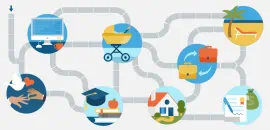

Key Takeaways
- Financial literacy lays the groundwork for informed decisions about credit, debt, saving, and investing.
- Many middle-income households struggle financially despite stable earnings, highlighting the need for better financial education.
- Limited financial knowledge can affect every part of your financial life, from overspending and poor credit use to missed saving opportunities and confusion around investing.
- Financial literacy programs can build early understanding around earning income, managing credit, and planning for goals.
- Online tools and financial education programs help individuals make daily financial decisions by providing credit reports, guidance, and resources.
Financial literacy may sound like a buzzword, but it’s more like a blueprint. One that could influence your daily choices, long-term goals & financial stability. Whether you're learning how credit works or trying to avoid debt traps, financial literacy offers a way forward.
What Is Financial Literacy?
Financial literacy refers to the understanding of key financial concepts and how to apply them in real life. It includes knowledge of topics like:
- Budgeting: Creating and sticking to a spending plan
- Saving: Putting money aside for future goals or emergencies
- Credit: Understanding how borrowing works, including credit card and loans
- Debt Management: Knowing how to handle existing obligations strategically
- Investing: Learning how assets like stocks or retirement accounts may grow over time
- Insurance: Protecting against risk through financial products
- Interest Rates: Grasping how borrowing and saving are affected by compounding
TIAA Institute GFLEC Personal Finance Index
Why Financial Literacy Matters in 2025
Financial pressures are increasing. The 2024 FINRA National Financial Capability Study (NFCS) found that more U.S. households are struggling to make ends meet and save for emergencies, even as incomes remain stable. Among the hardest-hit were middle-income adults earning between $25K and $75K, who showed larger declines in financial resilience, particularly around covering expenses, emergency savings, and credit behavior.2
What’s Driving the Concern?
- Saving for Emergencies Is Dropping: The share of adults who report having enough savings to cover three months of living expenses declined in recent years from 53% to 46%.2
- Financial Education Still Not Universal: According to the Council for Economic Education’s 2024 Survey of the States, just 35 states require personal finance education for high school graduation.3
- Educational Organizations Scaling Impact: As of 2024, the Jump$tart Coalition reports that hundreds of teachers reached tens of thousands of students through its network, with exponential educational impact as teachers stay active year after year.
- Digital Tools Are Gaining Traction: Usage of Khan Academy’s Personal Finance course has expanded in early 2025. Learners increasingly engage with content covering budgeting, saving, credit, and investing, suggesting growing demand for accessible, high-quality guidance.
How Financial Literacy (or the Lack of It) Affects Everyday Choices
The difference between thriving and struggling often comes down to the quality of your financial decisions. Without a foundation in financial literacy, everyday choices about debt, spending, and saving can become reactive, sometimes leading to long-term consequences that affect your overall financial health. But even a modest level of knowledge may help you navigate money more confidently and move toward sound financial decision-making.
Debt
Without financial literacy:
It can be difficult to recognize the long-term impact of borrowing. Many people take on student loans, credit cards, or financing plans without understanding how interest rates or repayment terms will affect their future.
Missed payments or overreliance on debit cards tied to overdrawn bank accounts can lead to fees, damaged credit, and escalating stress. Without a clear understanding of how managing credit works, it’s easy to fall into cycles of debt that are difficult to escape.
With financial literacy:
You may learn to distinguish between types of debt, such as high-interest revolving credit and lower-interest amortized loans like federal student loans. This can help when evaluating total repayment costs or selecting which debt to focus on first.
Financial literacy may also offer tools for managing credit responsibly. You may learn how to maintain low utilization, avoid late payments, and understand how credit scores work.
Spending & Budgeting
Without financial literacy:
Lacking a plan can make it hard to track where your money goes. Essential bills might be missed, while small everyday purchases made with debit cards or cash apps pile up. Without a working budget, it’s easy to spend beyond your means, especially when faced with irregular income or unexpected expenses. Many individuals lack even a basic bank account, which can limit access to safe payment methods or savings tools.
With financial literacy:
You may understand how to build a spending plan that reflects both needs and values. Budgeting helps prioritize goals, like paying bills on time, covering essentials, and setting aside a small emergency fund.
Even modest savings in a bank account with no maintenance fees could help you avoid turning to high-cost debt in a crisis. Financial literacy also encourages habits that promote financial health, such as planning ahead, tracking expenses, and being aware of spending patterns.
Saving & Investing
Without financial literacy:
Saving and investing can feel confusing or intimidating. Without guidance, people may delay building savings, overlook how debt repayment competes with savings goals, or invest in products they don’t fully understand.
Some may not know the difference between short-term and long-term savings vehicles, or the risks involved. As a result, they may miss out on growth opportunities or fail to build the cushions that support long-term financial health.
With financial literacy:
You may develop a clearer view of how to set short-term savings goals (like a vacation or emergency fund) alongside long-term priorities like retirement. Understanding compound growth could help you see the potential value of contributing consistently to a bank account, high-yield savings, or a retirement account like an IRA, even if the returns are not guaranteed.
Tailoring Financial Literacy for Families
Financial literacy isn't just a personal journey, it often starts at home. Teaching children and teens how to manage money early on could shape their approach to financial decisions, credit cards, and even investments later in life.
Start Young
Younger children may begin to build an understanding of money through simple routines, like earning income from chores or choosing how to spend their allowance. These everyday experiences can introduce concepts like saving, spending, and delayed gratification in a way that's easy to grasp.
Gamify Learning
Apps like BusyKid, Greenlight, and FamZoo offer fun ways for kids to track their earnings, set savings goals, and even practice using debit cards under parental supervision. These tools are designed to build confidence while reinforcing key lessons in financial education.
Model Real Financial Situations
Show your children how you make choices about household expenses—whether it’s building a grocery budget, comparing credit card offers, or saving for a larger goal. When they see how you handle everyday financial decisions, it may help them apply those lessons to their own lives later on.
Talk About the Risks
It's just as important to discuss the downsides like fraud, interest charges on credit cards, or the risks of taking financial advice from unverified sources online. Conversations like these may help them recognize red flags and build habits that support long-term financial well-being.
Connect to Bigger Goals
For teens, introduce topics like investment basics and what it means to build a solid credit history. Understanding these ideas early may help them feel more confident managing their own financial situations as they transition into adulthood.
Programs That Could Help Improve Financial Literacy
Not sure where to start? These programs may offer practical, accessible entry points.
| Program | What It Offers | Who It May Help |
|---|---|---|
| Jump$tart Coalition | Curriculum standards for K-12 and access to resources | Students, teachers, families |
| Khan Academy: Personal Finance | Free video lessons on saving, investing, and debt | Learners at any stage |
| Smart About Money (by NEFE) | Interactive courses and worksheets | Adults building financial confidence |
| Federal Reserve Education | Tools on economics, budgeting, and interest rates | Educators and families |
| MyMoney/gov (U.S. Treasury) | Official federal portal on saving, borrowing, and fraud | Anyone seeking reliable guidance |
Other Tools & Resources That May Help
Apps and websites are making financial education more accessible than ever. Some options to consider:
- YNAB (You Need A Budget): Teaches proactive budgeting methods
- Mint: Tracks spending and credit score in one dashboard
- Credit Karma: Provides credit reports and personalized tips
- MyFICO: Offers detailed breakdowns of credit score factors
Look for tools with transparent pricing (many offer free tiers), secure data practices and unbiased educational content.
Final Thoughts: Financial Literacy Is a Lifelong Tool
Financial literacy isn’t something you master overnight. It’s a skill set you can build over time with tools, support, and curiosity. Whether you're learning how credit works, navigating debt, or setting saving goals, building your financial knowledge could support more informed decisions.
Enhancing your financial literacy with smarter daily money choices may help build financial stability over time. Get My Free Financial Review
Frequently Asked Questions
How do you know if you are financially literate?
What are the 5 principles of financial literacy?
The five core principles of financial literacy include:
- Earning
- Spending
- Saving/Investing
- Borrowing
- Protecting
These principles provide a foundation of financial knowledge that may help students and adults alike make informed decisions across all stages of life.
Sources
- Global Financial Literacy Excellence Center. "The TIAA Institute-GFLEC Personall Finance Index (P-FIN Index)." https://gflec.org/initiatives/personal-finance-index/
- FINRA. "National Study by FINRA Foundation Finds More U.S. Households Struggling Financially Despite Stable Incomes."https://www.finra.org/investors/insights/finra-foundation-national-financial-capability-study
- Council for Economic Education. "Economic and Personal Finance Education in Our Nation's Schools." https://www.councilforeconed.org/wp-content/uploads/survey-of-states-2024.pdf
- Research Gate. "Integrating Financial Education into U.S. High School Curricula: A Pathway to Economic Mobility." https://www.researchgate.net/publication/385785744_Integrating_Financial_Education_into_US_High_School_Curricula_A_Pathway_to_Economic_Mobility














